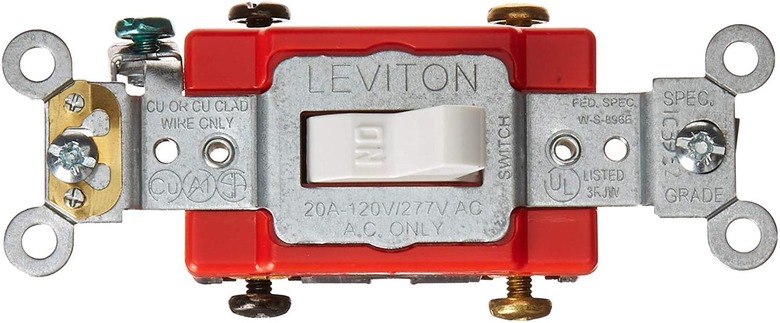How To Wire A 220-Volt Double-Pole Switch
We may receive a commission on purchases made from links.
Most electrical wall switches that aren't dimmers look more or less the same when mounted and in use. They have a cover plate and a toggle, and the power is on when the switch is in one position and off when it's in the other. Most of the switches in a typical house also look the same when you remove the cover and inspect the wiring. You'll see two brass screws on one side of the switch body, each connected to a hot wire (usually black) and a green screw on the bottom connected to a bare ground wire.
A switch for a large appliance that draws a lot of power, such as a pool pump or compressor, looks different under the cover plate. Instead of two brass screws, there are four — two on one side of the switch body and two on the other — and a green ground screw. The difference is because it's a switch for a 220-volt circuit. This type of circuit has two hot wires instead of one, which is why the switch needs four hot terminals.
Basics of 220-Volt Wiring
Basics of 220-Volt Wiring
Power comes into the main electrical panel at 220 volts (you could also say 240 volts; for all intents and purposes, they are the same). The wires that supply this voltage feed two separate bus bars in the panel, and when you want to hook up a 110- or 120-volt circuit for lights or appliances, you draw power from one bus bar or the other with a single hot wire (which is usually black) and a white return wire.
When you want to power an appliance that runs at 220 volts, though, you need hot wires from both bus bars, and you don't need a return unless the appliance has additional functions that operate at 120 volts. The hot wires for a 220-volt circuit are fatter than 120-volt wires, with 10 AWG being the minimum wire gauge you'd use.
Cable Colors for a 220 Switch
Cable Colors for a 220 Switch
When wiring a 220 switch, it's common to use two-conductor cable if the appliance has no auxiliary 120-volt functions. This type of cable includes a black wire, a white wire, and a bare wire. It's important to remember that because this is a 220-volt circuit, the white wire is hot, not neutral as it would be in a 120-volt circuit.
If you're using the switch to control an appliance that includes 120-volt accessories, such as a pool pump with lights or a timer, you would use three-conductor cable. In addition to the ground wire and the two hot wires, which are colored black and red, there's an additional white wire, and this time, the white wire is neutral, just as it is for a 120-volt circuit. This white wire will bypass the switch.
Hooking Up a 220 Switch
Hooking Up a 220 Switch
If you're using two-conductor cable, you'll have a line cable (from the panel) at the switch box with a black, white, and bare wire and a load cable (to the appliance) with the same three wires. A double-pole switch has two brass terminal screws, one on each side, and below them are two black terminal screws, again one on each side.
The black line wire gets connected to the black terminal on the left side of the switch, and the black load wire gets attached to the brass terminal above it. The white wires (which are hot, not neutral) get connected in the same way on the opposite side of the switch: line to black screw, load to brass screw. Twist the ground wires together and connect them to the green ground screw.
When using three-conductor cable, the black wires are connected in the way described above, but the red wires are connected on the other side, not the white ones. In this setup, the white wires are neutral, so they get twisted together and capped. The ground wires are again twisted together and connected to the ground screw.
